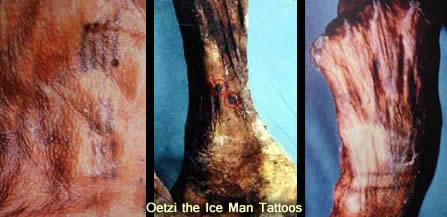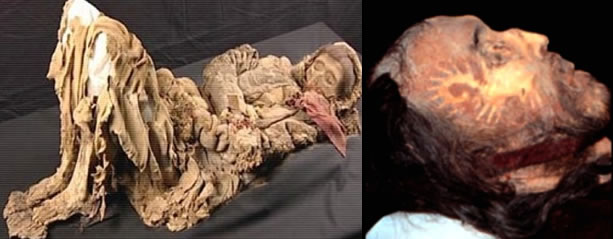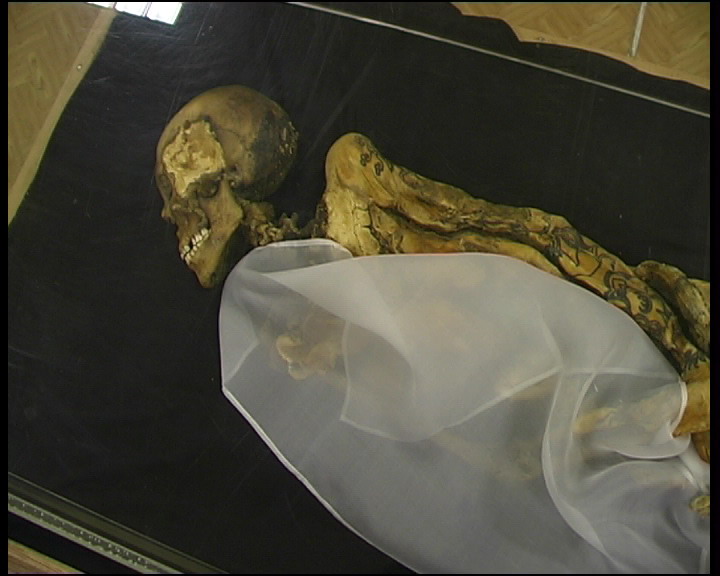
|
|
| Celeb Tattoos | Facts & Stats | Designs & Symbols | History | Culture | Links | Tattoo Galleries | Contact | |
|
ANCIENT TATTOOS: Theories of Heaven and Earth Article © 2009 PJ Reece Pleasure, Power, Duty Archeologists, when asked if the ancients were tattooed, are typically left holding a sack of fleshless bones, reminding us that tattoo is an ephemeral art, rarely surviving death. But where evidence has survived -- from entombed Egyptian mummies, to the burial mounds of horsemen of the Siberian Plain, to Paleolithic tattoo implements found in prehistoric caves in Spain -- it would appear that tattoos were indeed a feature of prehistoric cultures. We know from studying indigenous peoples in the modern era that tattoos have not been merely decorative, rather, they were charms for protection, amulets for good luck, marks of shame or glory, symbols of faith, proof of maturity or readiness for marriage or battle. They served the sensual, erotic, and emotional aspects of the psyche, providing a source of power, and perhaps more importantly, a reminder of the tattooed citizen's social duty. Animals were the dominant tattoo motifs in ancient times, and represented personal or clan totems, sometimes imbuing the believer with its spirit. If it was a case of 'mind over matter', it's a psychic feat that today's tattoo aficionado still engages in. From the jungles of Borneo to the tattoo studios of L.A., we humans continue to adopt and display those symbols that resound with unnamed passions deep within us. Mysterious and powerful, this relationship of inner to outer - the skin being the dividing membrane -- is nothing less than the psychic origin of tattoo. An examination of the most ancient tattoo cultures should shed light on this 'imaginal' world from where all tattoo motifs originate. Due to the lack of preserved skin from ancient times - mummified bodies being exceedingly rare - the journey in search of the earliest tattoos finds us on our knees examining fragments of clay figurines that display tattoo-like etchings. Detectives may even pick up the trail in a stanza of ancient poetry, or resort to examining myth. From Ancient Greece comes the famous story of Helen of Troy, in which the legendary beauty is abducted by the Trojan, Paris. For his protection, Paris was tattooed as a charm against the arrows of Helen's jealous husband. (Alas, the resulting Trojan Wars saw Paris killed in the end.) Another legend, that of Orpheus, tells of that mythic poet's failed attempt to retrieve his wife from the Underworld. In the aftermath of his grief he wooed young men with his seductive songs, which so enraged Orpheus' female admirers that they tore him limb from limb. The point is not that Orpheus may or may not have deserved such a fate, but that the women tattooed themselves to commemorate their deed (or were tattooed as punishment). The point is - for tattoo hunters both professional and amateur - the ancient myths of Paris and Orpheus speak of tattooing. The school of 'depth psychology' suggests that archetypal stories (myths) and images underpin our culture and are synonymous with 'soul'. But the old-fashioned scientist in us wants to follow a real trail of blood back to 'where it all started'. Which begs the question - was there a single source to tattooing, a dominant culture from which the art was disseminated around the world (the 'diffusion theory')? Or did tattooing emerge separately and individually in each culture ('independent evolution') as a common response to the very human need to feel more comfortable in one's own skin? Once again, archeologists can't provide us with definite answers. Diffusion, after all, is an entirely mental event, a phenomenon that leaves no archeological footprint. Where did it all start? The word 'tattoo' - or 'tattaw' - was imported to Europe by the British Capt. James Cook and his crew on their return from their trading expedition to Tahiti, arriving home in July, 1771. The word didn't exist in the West because tattooing was virtually unknown. Disembarking at Plymouth, Cook must have been less excited by his cargo of exotic fruits than by his logbooks full of celestial observations from the Southern Hemisphere, and his journals describing Polynesian culture. His notes pin-point the moment in time when 'tattoo' entered the English lexicon:
For display purposes, Cook brought with him a heavily tattooed Tahitian chief, reinforcing the belief that tattoo was synonymous (exclusively so) with the culture of the South Seas. Had Cook's expedition kept going, they might have discovered that headhunters in Borneo were applying tattoos to ensure their safe passage across the River of Death and into the afterlife. And, half a world away, the Aztecs were imprinting their skin with indelible reproductions of their powerful and ruthless gods, while the Yupik women of the Bering Strait were stitching tattoos into their faces to dispel evil and attract prey animals -- and husbands as well. In Thailand, Buddhist monks were bolstering their spirits and attracting good fortune by tattooing each other with religious designs and icons. And tribes from Africa to North America were practicing body modification rituals in order to transform adolescents into responsible members of the tribe. Captain Cook's crew would have been even more astonished to learn that Western cultures, too, had a long but forgotten history of tattooing. So complete was European amnesia that, even now, it's difficult for many anthropologists to accept that Caucasians may have been responsible for disseminating tattoo culture (and other inventions) to much of the world. One of these distant tattooed relatives was discovered less than twenty years ago, providing scientists with their best-preserved Bronze Age corpse - and some of the oldest evidence of tattoo culture. Ötzi, the Iceman In 1991, high in the Ötz Valley on the glaciated border between Austria and Italy, hikers found a frozen body. A melting glacier had only recently released it from its icy grip. But this was no missing tourist, but a prehistoric hunter (or was he a herdsman or a shaman?) complete with bow and arrows and bronze axe -- 5200 years old. A forensic examination of the body revealed that the 45-year old man had been shot in the back with an arrow and left to die in a snowstorm. Buried and preserved by that long-ago winter, Ötzi then waited in his icy tomb for an era of global warming to once again show off his tattoos. He had 58 of them. Ötzi's tattoos weren't decorative, however, since they were inked on parts of the body not easily displayed. Furthermore, they weren't pictorial, rather they were dots and lines and small crosses.
A group of scientists from the University of Graz in Austria suspected a relationship between Ötzi's tattoos and traditional acupuncture points. If they were correct, then acupuncture had been in use in Europe 2000 years earlier than previously thought. X-rays revealed many of Ötzi's joints to be arthritic, including his lumbar region. Nine of the mummy's tattoos were inked on the urinary bladder meridian, commonly associated with treating back pain. One cross-shaped tattoo is located by the left ankle (on point UB60) which many therapists consider to be a 'master point for back pain'. Given the particular combination of points, it seems that Ötzi was being treated with a 'meaningful therapeutic regime'. Furthermore, Ötzi's intestines were infested with whipworm eggs, a sure sign he suffered from abdominal pain. Five more of his tattoos corresponded with points on the meridian traditionally used to treat stomach disorders. If Ötzi's tribe were practicing 'Chinese medicine', then according to the diffusion theory other shamanistic cultures must have done so, too. Civilizations from East and West must have crossed paths, transacted business and traded cultural practices long before most people believe. The evidence for just such a racial interaction comes from Central Asia, where Chinese authorities have been more or less successful at keeping the story under wraps. China Central Asian Caucasoids, tall people with red hair and green eyes, had long been the subject of Chinese legend. Then, in the early 20th century, archeologists digging in the Tarim Basin in western China, unearthed mummies resembling the legendary creatures. At first, no one leapt to any conclusions. The prehistoric graveyard must have marked the final resting place for an unfortunate band of migrants. But more recently, Chinese archeologists working in the Taklamakan Desert, made further discoveries that forced them to reconsider - hundreds more Caucasian mummies, many of them tattooed with geometric designs. They were clothed in garments resembling Celtic plaid, complete with tam-o'-shanters and Robin Hood caps. Perhaps the ancient Chinese legends were accurate.
Radiocarbon dating established the mummies as living during the height of the Bronze Age, in the 21st century BC. Italian geneticist, Paolo Francalacci, tested the DNA of a few of the mummies and found two of them to be related to modern-day Swedes, Finns, Tuscans, Corsicans, and Sardinians. Struck by the similarities between Ötzi the Iceman and these Caucasoid mummies, Sinologist, Victor Mair, remarked, "These guys out in the Tarim (Basin) are just like him - one's in ice and the others are in sand." These were an Indo-European people, cousins of the Celts and Scythians, a branch of the family that may have controlled the Silk Road to Europe from 2500 BC to 400 BC. As traders, they would have influenced cultures as far as their travels took them, certainly to the tattooed horsemen of the Siberian plain, and possibly as far west as the Celts and the painted Picts, and southwards to the tribals of India. Possibly even to Japan, spreading their Caucasoid tattoo culture to the ancestors of Japan's indigenous Ainu. If enterprising Caucasians might have once inhabited Xinjiang province, it was a theory that the Chinese government wanted 'classified'. The version of history they guarded was of a Chinese civilization blossoming in isolation, without any Western influence. Consider, too, that the mummies were exotically tattooed - tattooing had been a crime in China for over two centuries. The less said, the better. But not far from the Chinese discoveries, in Russia, on the western edge of the Siberian Plain, dramatic evidence of an ancient tattoo culture was unearthed. And this time, highly publicized. Horsemen of the Siberian Plain In 450 BC, the Greek writer Herodotus wrote about Scythian nomads to the north, tribes of horsemen who ruled the Eurasian Steppe by horseback, their tattoos acting as 'a mark of nobility, and not to have them was testimony of low birth.' Sceptics assumed Herodotus was dreaming, and held to that opinion for over 2000 years. But in 1948, not far from the border with China, a Russian archeologist named Rudenko discovered an astonishingly well-preserved corpse in a frozen Pazyryk burial mound - and ice-bound Scythian chieftain covered with tattoos of mythical animals. He would have been alive as Herodotus was writing about him. The Pazyryks were formidable Iron Age horsemen and warriors. The artifacts found with the mummies suggest they had an appreciation for art - saddles, rugs, clothing, jewelry, musical instruments, amulets and tools and fabrics from Persia and China. But the most artistic of all the wonders were the tattoos, an interlocking array of fantastic beasts on the mummy's arms, shoulder, torso, and one leg. When the evidence was made public, much interest focused on a pair of stylized deer and a mountain ram on the chief's right arm. Stylistically, they recalled the art of Persia, Assyria, India, and particularly China. Boldly graphic, this 'animal style' art influenced cultures wherever the Scythians roamed. On the chief's chest were a pair of fabulous griffin-like monsters. On his right leg, a fish extended downward from the knee to the foot, where a monster took over. Inside the shin Rudenko found a unified design of four rams on the run. The chief's other leg was also tattooed but less clearly. On his back were a series of small circles in line with the vertebrae, most likely a strategy to ease back pain, since modern era horsemen in Siberia deploy a similar tactic. Over the years, the Pazyryk burial mounds would produce more frozen mummies, but none more exciting than the 'Ice Maiden'. In 1993, the Russian Academy of Sciences went hunting with the latest arsenal of archeological technology and were rewarded with the discovery of another frozen corpse, this one a young woman of obviously high birth, a 'warrior-priestess' buried with six horses. (Some of the burial mounds were up to 100 metres in diameter.) Her white silk dress, elaborate headdress and exotic jewelry were an exciting find, but upon discovering flesh they began peeling back the fabric over her shoulder to reveal dark blue tattoos - once again those familiar mythical creatures. One striking image portrayed a deer's horns morphing into flowers, the muzzle becoming the beak of a bird.
Were these beasts simply imaginary? Or were their origins to be found deeper in the human psyche? Were they 'imaginal' - did they arise unbidden from some subtle realm from which we derive our humanity? To an ancient, the skin might have been perceived as the boundary between 'inner and outer' - between that which he did and didn't understand. Our ancestors may have deployed these fantastical creatures to patrol this vulnerable membrane, this liminal zone between worlds.
The Ice Maiden had more tattoos on her wrist, and one on her thumb. One of her tattoos so closely resembled the chieftain's that it was either drawn from the same stencil, or perhaps by the same artist. This recurring 'deer' motif has puzzled the experts, not least because its convoluted posture with hind legs turned upward suggests an altered state. Signifying what? That those hooves no longer touched this earth? That the Pazyryks celebrated transcendence or spirituality has the support of author, A.C. Aufderheide. In The Scientific Studies of Mummies (2003) he describes the largest Pazyryk burial mound as being 100 metres across and containing not only the royal deceased but many of his horses arranged in spoke-like fashion around the central tomb. Aufderheide writes, "Alignments of the galleries with stone mounds in the surrounding area strongly implies that this burial structure has astrological and probably ritual relationships." If the Pazyryk horsemen had rituals, then rites of passage to adulthood might well have been one of them. An examination of the tattooed mummies' subcutaneous fat revealed it to be free of ink, while the deeper layer of muscle was discoloured. Clearly, these tattoos were applied when the person was young, before he put on that layer of fat, later in life.
It's impossible to walk a mile in a Pazyryk tattoo, because the psyche of modern man has changed radically in 2500 years. Archaic man was not 'individualistic', according to mythologist Joseph Campbell. At least, not beyond the egocentrism of early childhood. Ancient man was socialized into an archetype that would serve the tribe. "And it was precisely in the rites of initiation," says Campbell, "that his apotheosis (from person to status of god) was effected." The childhood psyche required an intense experience to cause it to disintegrate -- followed by a meaningful ritual that reintegrated or reorganized it into a worldview that valued social duty above all other concerns. "Throughout the world, the rituals of transformation from infancy to manhood are attended with, and effected by, excruciating ordeals," says Campbell. There are more painful rites than acquiring a tattoo, but the person is transformed nevertheless into an indelible statement of his spiritual state. Consider the heavily tattooed Pazyryk chieftain -- could he have behaved other than in a manner befitting his mystical animal totems? Perhaps the people had faith that their chief's tattoos would elevate him to the position of trust that they required of him. We'll never know. |
|
|
|
|
| Celeb Tattoos | Facts & Stats | Designs & Symbols | History | Culture | Links | Tattoo Galleries | Contact | |




